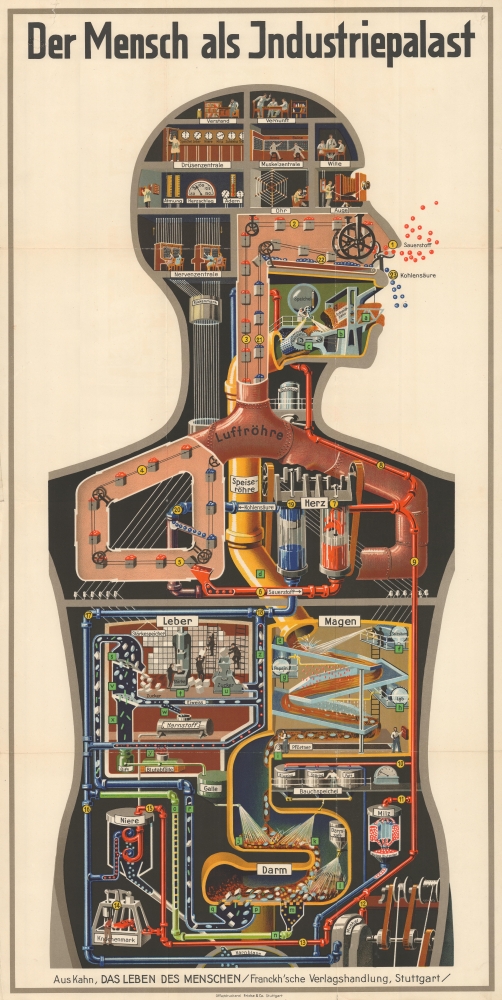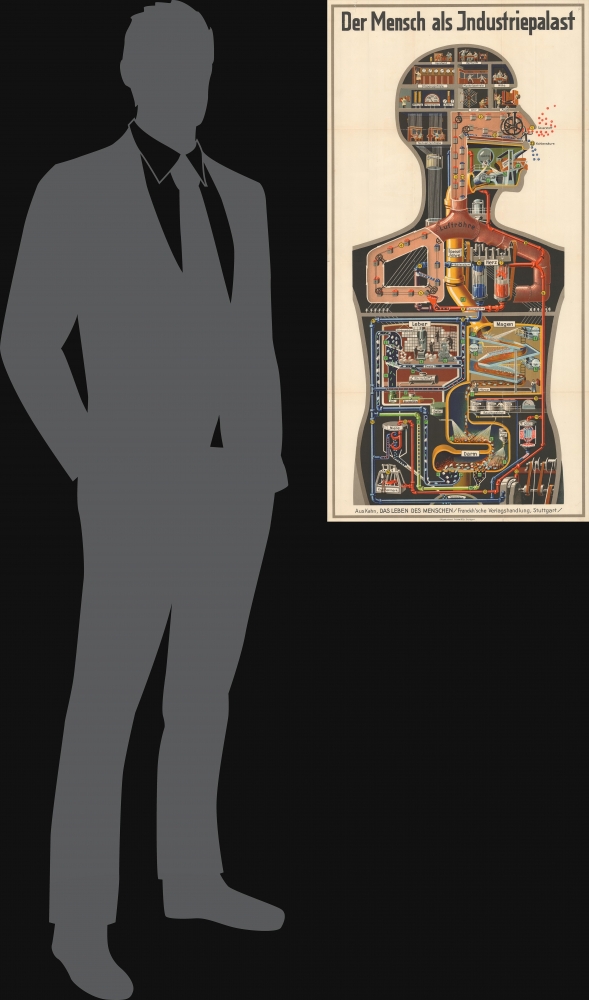1926 Kahn Lithograph 'The Human as an Industrial Palace'
MenschIndustriepalast-kahn-1926
Title
1926 (undated) 37.5 x 18.75 in (95.25 x 47.625 cm)
Description
A Closer Look
Similar to an anatomical schematic, the human body is displayed with its various organs and systems labeled, but with each represented by a machine or series of machines. Numbers denote stages in the process of respiration and circulation (beginning with the inhalation of oxygen and ending with exhalation of carbonic acid), while letters indicate stages in digestion, the conversion of energy, and the functioning of organs. Different 'rooms' of the 'industrial palace' contain their respective organs, including the liver (leber), heart (herz), stomach (magen), colon (darm), kidney (niere), and so on. The brain is presented as a complex set of machines and electrical wires, with different control centers for the body's organs and systems. Throughout, 'workers' lift chemical compounds and run the machines, while 'managers' and switchboard operators make decisions and coordinate functions in the brain (this vertical spatial differentiation between workers and managers is reminiscent of the opening scenes of Fritz Lang's Metropolis, another great cultural product of Weimar Germany, released one year after Kahn's infographic).Medicine for the Masses
A prolific writer, Kahn was known for making complex scientific concepts and information accessible to a wider audience, especially through his conceptualization of illustrations that used metaphors to explain the human body. These works were so effective that they had international currency. 'Der Mensch als Industriepalast' has had a particularly strong and lasting appeal, spawning unauthorized reproductions and imitations, including a poster published in Shanghai in 1933 titled 'The Human Body is Like a Factory' (人體好像工廠).Publication History and Census
This work was conceived by Fritz Kahn and appeared as a supplement to the second volume (1926) of his Das Leben des Menschen, published in five volumes between 1922 and 1931. It was printed by Fricke and Co. and published by Franckh’sche Verlagshandlung, both of Stuttgart. It is only independently cataloged by the New York Public Library, while the entire five-volume work is more widespread. As mentioned above, several official and unofficial translations of 'Der Mensch als Industriepalast' were produced in the years after the original's publication, including several English editions (titled 'The Human Factory'). Both the German original and the English translation are scarce to the market.Cartographer
Fritz Kahn (September 29, 1888 - January 14, 1968) was a German-Jewish writer and physician known for his innovative and memorable infographics relating to medical and scientific topics. Kahn's life was defined by frequent travel; having been born in Halle, during his childhood he briefly emigrated to the United States and then returned to Germany, moving several times before settling in Berlin, where he finished his gymnasium. He then attended medical school at the University of Berlin but retained a wide interest in multiple fields of science. In addition to serving as a medic in the First World War, he published articles on scientific topics in popular publications (his father was also a writer and physician), and joined expeditions to the Arctic and Sahara Desert. With the rise of Hitler, he emigrated to Palestine and then to Paris. After being detained by France in the early phase of the Second World War (due to his German citizenship), he was able to secure release and then gradually make his way to the U.S. In the postwar period, he primarily settled in Switzerland but also spent periods in the U.S. and Denmark. Kahn published more than 20 books throughout his lifetime, which were especially known for their striking illustrations (conceived by Kahn and drawn by others). He was especially fond of comparing the human body to a mechanical instrument and considered it the most sophisticated machine in the world. Kahn's works were suppressed in Germany by the Nazis, retroactively obscuring his prominence during the Weimar period, but he gained a degree of international recognition in the postwar period. More by this mapmaker...




